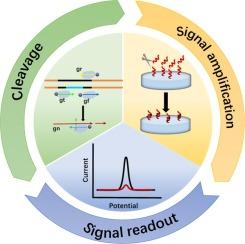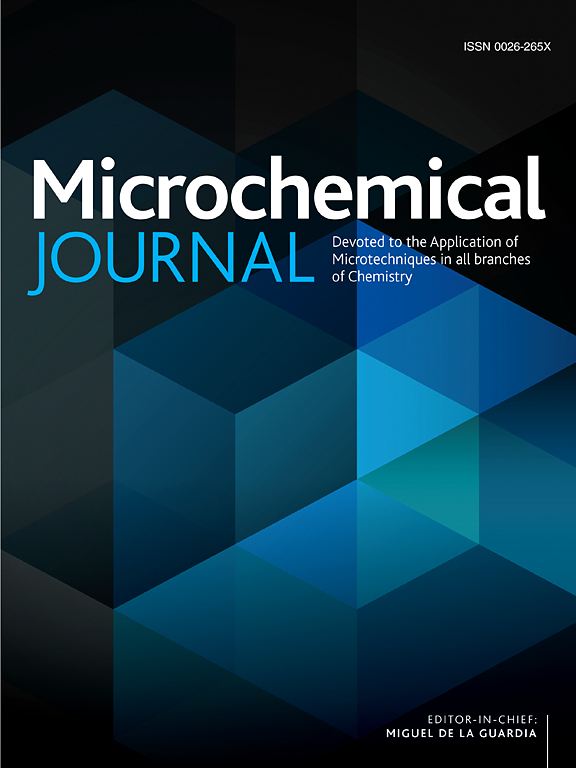Detection of parvovirus B19 genomic fragments using an electrochemical biosensor based on argonaute-assisted silver metallization
IF 4.9
2区 化学
Q1 CHEMISTRY, ANALYTICAL
引用次数: 0
Abstract
The human pathogen Parvovirus B19 (B19V) is known to cause a spectrum of diseases. Presently, no vaccines or antiviral medications are accessible for its prevention or cure. This highlights the pressing need for the advancement of efficient and affordable diagnostic technologies in vitro, which are essential for managing and curbing the spread of infectious diseases. In our research, we have introduced an innovative nanocomposite material, g-C3N4/DWCNT-COOH/PtNPs, synthesized via a one-step hydrothermal process. This material is applied on the electrode surface to enhance the primary signal. The capture probe cDNA is affixed to the electrode via a Pt-S bond, a method that ensures a stable immobilization for detection purposes, and in conjunction with nucleic acid detection mediated by Clostridium butyricum Argonaute (CbAgo) from the mesophilic bacterium, an electrochemical Argonaute biosensor utilizing silver metallization was constructed, targeting the non-structure protein 1 (NS1) region of the virus genome. Benefiting from the lack of sequence constraints similar to the Protospacer Adjacent Motif (PAM), CbAgo can utilize an easily designed and cost-effective guide DNA (gDNA) to recognize the target sequence. By incorporating a polymerase chain reaction (PCR) pre-amplification step, along with silver metallization for secondary signal amplification and electrochemical analysis techniques, a highly sensitive and specific detection is obtained. The biosensing platform exhibits a detection range from 10-17 M to 10-12 M, with a detection limit as low as 2.62 aM. Compared to current detection methods for this virus, it demonstrates superior analytical performance and validates its effectiveness for use with real serum samples.

基于氩辅助银金属化的电化学生物传感器检测细小病毒B19基因组片段
已知人类病原体细小病毒B19 (B19V)可引起一系列疾病。目前,没有疫苗或抗病毒药物可用于预防或治疗。这突出表明迫切需要提高有效和负担得起的体外诊断技术,这对于管理和遏制传染病的传播至关重要。在我们的研究中,我们介绍了一种创新的纳米复合材料g-C3N4/DWCNT-COOH/PtNPs,通过一步水热法合成。这种材料被涂在电极表面以增强初级信号。将捕获探针cDNA通过Pt-S键固定在电极上,以确保检测目的的稳定固定,并结合中温细菌Clostridium butyricum Argonaute (CbAgo)介导的核酸检测,构建了一个利用银金属化的Argonaute电化学生物传感器,靶向病毒基因组的非结构蛋白1 (NS1)区域。得益于缺乏类似于Protospacer邻基序(PAM)的序列约束,CbAgo可以利用易于设计且成本低廉的引导DNA (gDNA)来识别目标序列。通过结合聚合酶链反应(PCR)预扩增步骤,以及银金属化用于二次信号放大和电化学分析技术,获得了高灵敏度和特异性的检测。该生物传感平台的检测范围为10-17 M ~ 10-12 M,检测限低至2.62 aM。与目前的病毒检测方法相比,该方法显示出优越的分析性能,并验证了其用于真实血清样本的有效性。
本文章由计算机程序翻译,如有差异,请以英文原文为准。
求助全文
约1分钟内获得全文
求助全文
来源期刊

Microchemical Journal
化学-分析化学
CiteScore
8.70
自引率
8.30%
发文量
1131
审稿时长
1.9 months
期刊介绍:
The Microchemical Journal is a peer reviewed journal devoted to all aspects and phases of analytical chemistry and chemical analysis. The Microchemical Journal publishes articles which are at the forefront of modern analytical chemistry and cover innovations in the techniques to the finest possible limits. This includes fundamental aspects, instrumentation, new developments, innovative and novel methods and applications including environmental and clinical field.
Traditional classical analytical methods such as spectrophotometry and titrimetry as well as established instrumentation methods such as flame and graphite furnace atomic absorption spectrometry, gas chromatography, and modified glassy or carbon electrode electrochemical methods will be considered, provided they show significant improvements and novelty compared to the established methods.
 求助内容:
求助内容: 应助结果提醒方式:
应助结果提醒方式:


